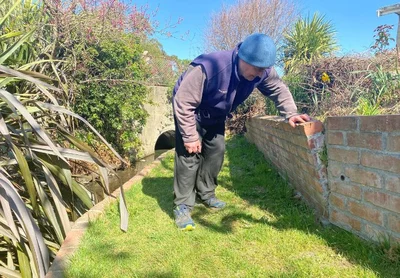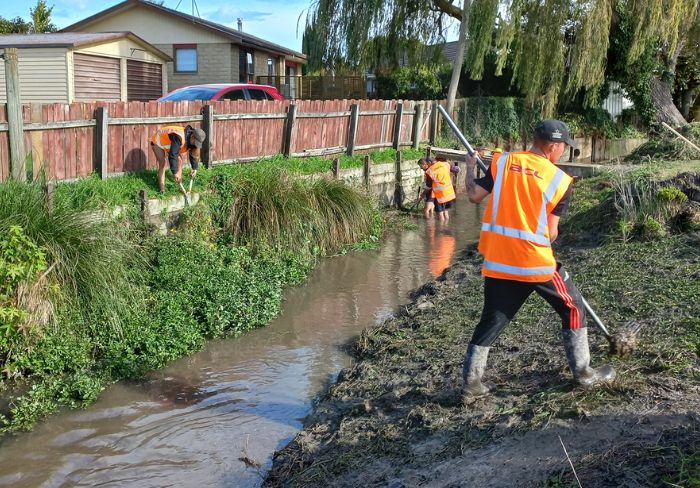Frustrated residents demand action on flood-prone creek

Carters Creek residents are fed up. The property owners are demanding solutions and accountability about the ongoing flooding issues with the creek that runs through their Tinwald homes. LDR reporter Jonathan Leask explains.
Flooding and erosion issues along Carters Creek are being treated like a tennis ball and it’s reaching breaking point, resident Keith Gundry says.
He is just one of the property owners fed up with a lack of action over a flood-prone creek that runs through Tinwald.
“It’s a small creek generally, but it becomes quite a large river when these significant amounts of water come in, and it's not set up for these volumes of water,” Gundry said.
“There are consented homes by this drain that are now being affected.”
In July, heavy rain caused several properties to be inundated by water from excessive stormwater flows along Carters Creek, Gundry said.
“It is very clear that the creek is not properly equipped to handle excess stormwater flows through urban Tinwald.”
The flooding is eroding the creek’s banks and starting to affect buildings and property, Gundry said. The affected property owners want action.
Some neighbours have already complained to Environment Canterbury (ECan) and the council, he said.
“No one seemed to be getting action and nothing seemed to be happening.”
Gundry is part of the Carters Creek Catchment Group, which was formed earlier this year to address the drainage and water quality issues of the waterway.
The group consists of urban and rural members, including Lake Hood residents impacted by the creek.
It gained funding from the Ashburton Water Zone and held several meetings with ECan to discuss the approach to water quality and science investigations.
Then on July 23, it flooded again.

The focus moved from water quality issues to drainage.
It's not a case of throwing stones, just seeking solutions, Gundry said.
The catchment group, referring to a 2009 ECan report, want several actions including a review of the culvert sizes as some are not big enough to handle the flows.
At Jack Stott’s property, the water backs up from the culvert adjacent to his house and is eroding the banks, causing stability concerns for his home.
The group also wants flow gauges, annual cleaning, and a review of the stormwater management and system performance.

Who is responsible?
The responsibility for the creek is a grey area, so the residents' concerns “get tennis balled”, Gundry says.
As it is a waterway, classified as a drain, it is under ECan's jurisdiction, but some of the issues related to stormwater management are under council jurisdiction.
ECan rivers manager David Aires said the regional council has been aware of the Carters Creek flooding issues for a long time.
“We have been involved in various discussions with Ashburton District Council and landowners for a number of years, with studies and investigations into these issues dating back to the early 2000s.
“There are complexities as a result of the varying responsibilities of different parties.”
Carter’s Creek is part of the Ashburton Hinds Drainage Scheme that is administered by ECan and is set up to provide land drainage, Aires said.
“It does not collect rates to fund flood protection, which means our role here is to carry out any required works to maintain a clear waterway.
“We carry out regular inspections of the waterway and any works required to meet the agreed level of service.
“While we are responsible for maintaining the channel, we do not own or maintain the culverts in the waterway.
Any issues during its inspections are passed onto the asset owner, such as Waka Kotahi, the council or landowners.
The ‘Mill Creek solution’
The catchment group has pointed to the Mill Creek enhancement project and how a similar project could be instigated on Carters Creek to solve the issues.
Council chief executive Hamish Riach described Mill Creek as the “exception” to the rules around waterways.
That is because it is a stormwater drain through the urban area and therefore beyond what is classified as stockwater, he said.
Due to its classification, its management is rated for by the district council, not ECan.
“It is part of our stockwater network, Carters Creek is not,” Riach said
Mill Creek has had major stabilisation and enhancement works between 2009 and 2017, when retaining walls and rock banks were created along its length through Ashburton town.
Similar works and management along Carters Creek will likely require a targeted rate to be introduced by ECan to fund it, which would need to go through the Long Term Plan process.

Paying for progress
Since the Carters Creek catchment group fronted the Ashburton Water Zone at the end of August, there has been some talk of action.
ECan councillor Ian Mackenzie discussed Carters Creek with ECan’s river engineers. The indicative cost for remediation is around $2-3 million.
“We know what needs to be done, it’s a question of whether the community wants to fund it,” Mackenzie said.
“Unfortunately, the situation is always somebody has to pay.
“We can fund it through a targeted rate on that part of the drainage district, maybe incorporating some of Lake Hood, and we could capitalise some of the cost perhaps, and some of the cost would be through the district council.”
If it is categorised as a drainage issue more than flood protection, funds could come from the Ashburton Hinds drainage rating district.
ECan rivers manager David Aires said Carters Creek was discussed at a recent river rating meeting, where it was decided that the scheme would not solely fund any flood protection measures on Carters Creek.
Mackenzie said the scheme's budget isn’t sufficient to cover the work and it's "outside the scope of the Ashburton Hinds drainage district”.
“That’s about draining the land, it’s not about preventing flooding in the first place so it’s a crossover.
“We have an ECan report on what needs to be done to prevent the problem, we just now need the okay from the community as to whether they are prepared to put their hands up to fund it.
“There may be parts of the work we can do that may not involve as much money but we need some clarity as to how we should approach it so we can get more finite numbers on what the costs will be.”
The next step is for ECan to sit down with the district council and the Carters Creek catchment group to discuss the options, Mackenzie said.
Those conversations will then feed into ECan’s long-term plan, which will lay out the options, costs/funding for the community to consider in the consultation process.

